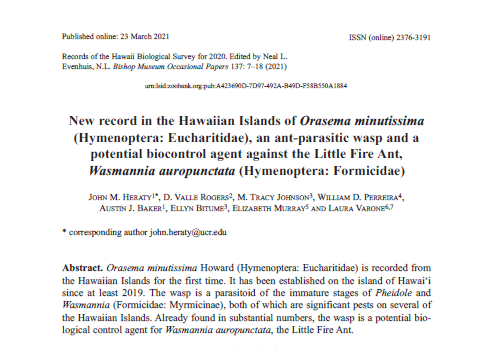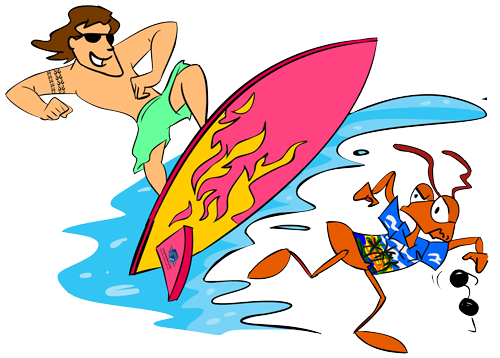Recently, researchers detected a new parasitoid wasp (Orasema minutissima) in the South Hilo and Puna districts of the Hawai‘i Island. This is exciting news since this species of wasp is known to parasitize Little Fire Ants (LFA) throughout parts of their native range and in the Caribbean. Right now, we don’t know how long the wasp has been in Hawai‘i or how widespread it is. We are doing what we can, when we can, to help the researchers determine distribution.
So, this sounds exciting, right?! But what does it ACTUALLY mean for LFA control?
Short Answer:
We don’t know and only time will tell.
Longer Answer:
Biocontrol is based on complex natural interactions between a target pest and naturally occurring predators/herbivores, parasitoids, and pathogens. In Hawai‘i, our ecosystems are very sensitive and we need to be certain that any possible biocontrol agent intentionally introduced will “do its job” and not negatively affect other things. This can take YEARS (or even decades) of research.
When it comes to ants, biocontrol is very difficult. There have been a number of entomopathic fungi (insect infecting fungi), flies, pathogens, and wasps identified that will attack certain ant species but these biocontrol agents are very host specific and generally affect only a few species of ants. To make matters worse, ants know where danger lurks and are really good at protecting the colony. They will avoid areas where entomopathic fungi and other disease-causing agents are present, quarantine or kick out infected nestmates, or even completely move the nest to a new location; all in the name of colony survival. These are just some of the reasons the public doesn’t see much effort into LFA biocontrol. The reality is, researchers around the world have looked into this. There have been a couple of biocontrol agents identified that DO attack LFA but, so far, none have shown potential to noticeably reduce LFA populations. It’s not uncommon in the world of biocontrol to need multiple bicontrol agents for a single target pest in order to achieve population reductions.
None of this means it will “never” happen. It only means that effective biocontrol for LFA hasn’t been identified YET.
Now, let’s talk about this cute little parasitoid wasp O. minutissima. These wasps are ADORABLE little guys with a very interesting life history. After mating, females lay their eggs in fern leaves. When the eggs hatch, LFA will bring O. minutissima larvae into the nest and feed them to LFA larvae. After being eaten, a wasp larva basically just hangs out INSIDE of the LFA larva until the LFA larva pupates. This is when O. minutissima really starts to shine! During pupation, the wasp larva leaves and becomes an external parasitoid on the LFA pupa, growing and feeding off the LFA pupa). While in the nest, the wasp larvae and pupae are protected, cared for, and treated like “one of the family”. When they emerge as an adult wasp, they leave the nest to mate and start the cycle all over again.
O. minutissima has only been recorded throughout the Caribbean, Costa Rica, Colombia, and Guyana (until now). LFA are native to all of these locations except the Caribbean and are known as a major pest, even throughout much of its native range; even in places where O. minutissima are present. It is clear that O. minutissima attack LFA but it’s NOT clear that they have any impact on LFA populations. There are so many factors influencing whether LFA become a serious pest in their native range, it’s hard to tease out how much is due to natural enemies like O. minutissima. Most natural enemies that attack a target pest, like LFA, won’t actually reduce populations very well on their own. This is why a good biocontrol agent is hard to find.
Only time will tell whether or not this new introduction will have any noticeable impact on LFA in Hawai‘i. Any possible impacts (if any) are not likely to be realized for MANY years since it takes time for biocontrol population to grow and spread. No matter how exciting this news is, let’s keep in mind, there is no such thing as a “silver bullet”. Controlling LFA still requires the use of ant baits and prevention practices. This isn’t likely to change anytime soon (if ever). The best we can realistically hope for from this new introduction is that it might compliment bait treatments and become part of our integrated pest management approach to control LFA as a beneficial insect.
You can read the full scientific paper here.

